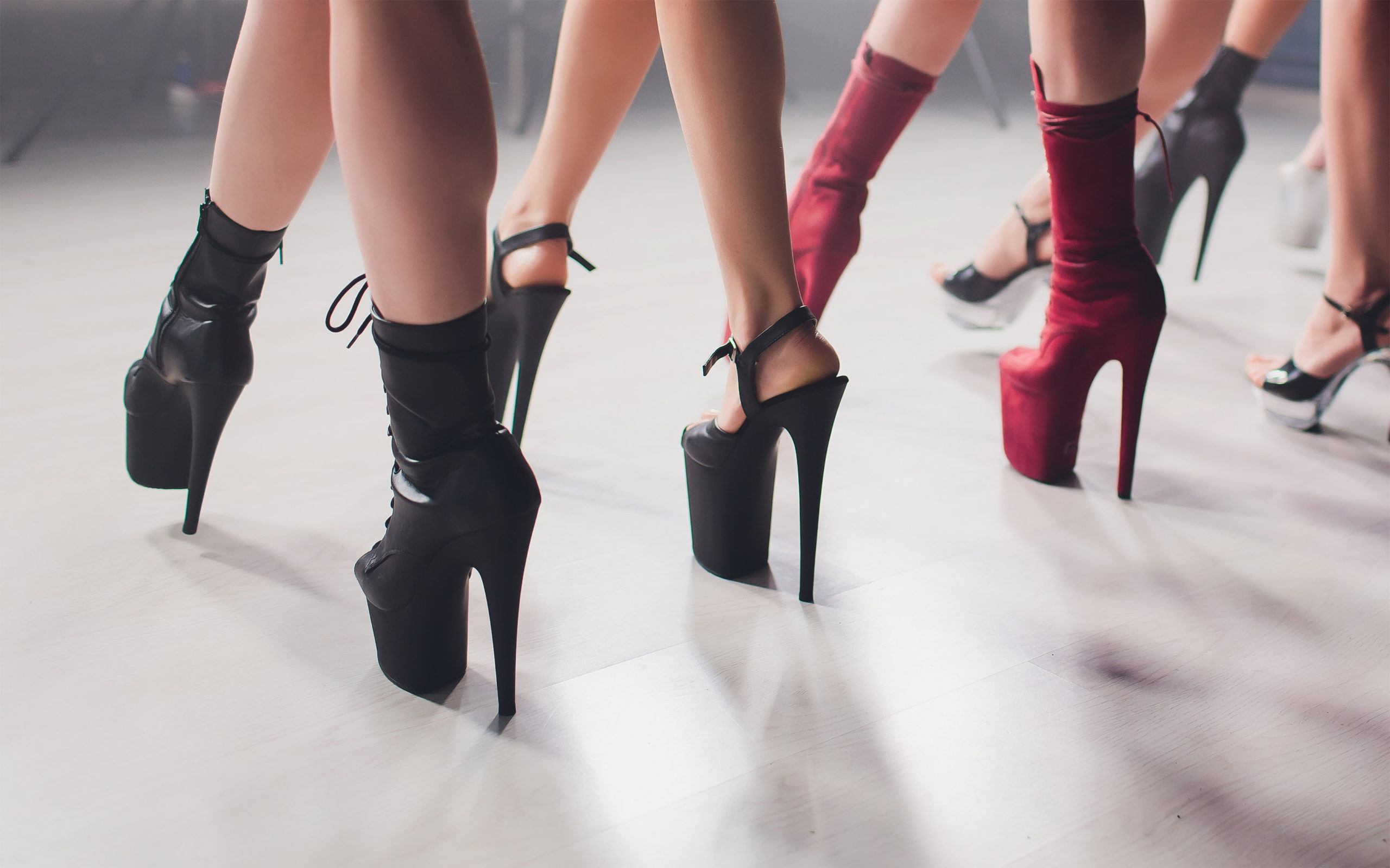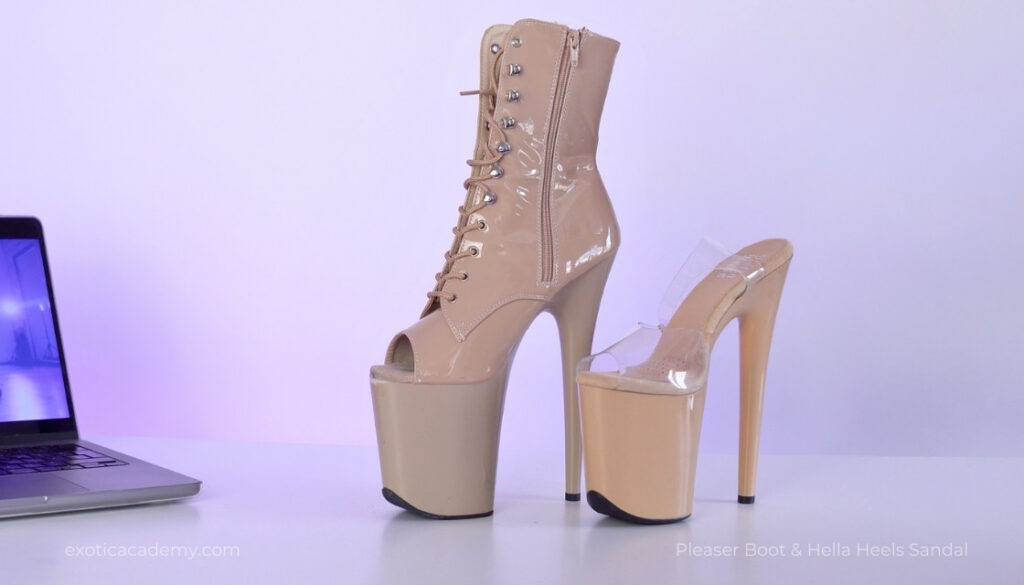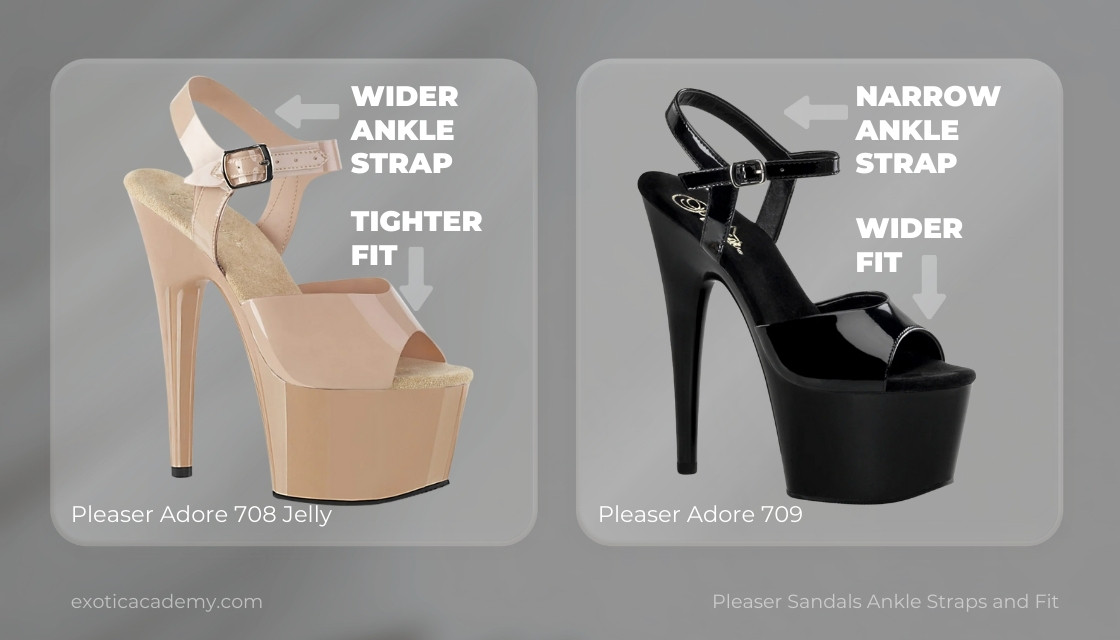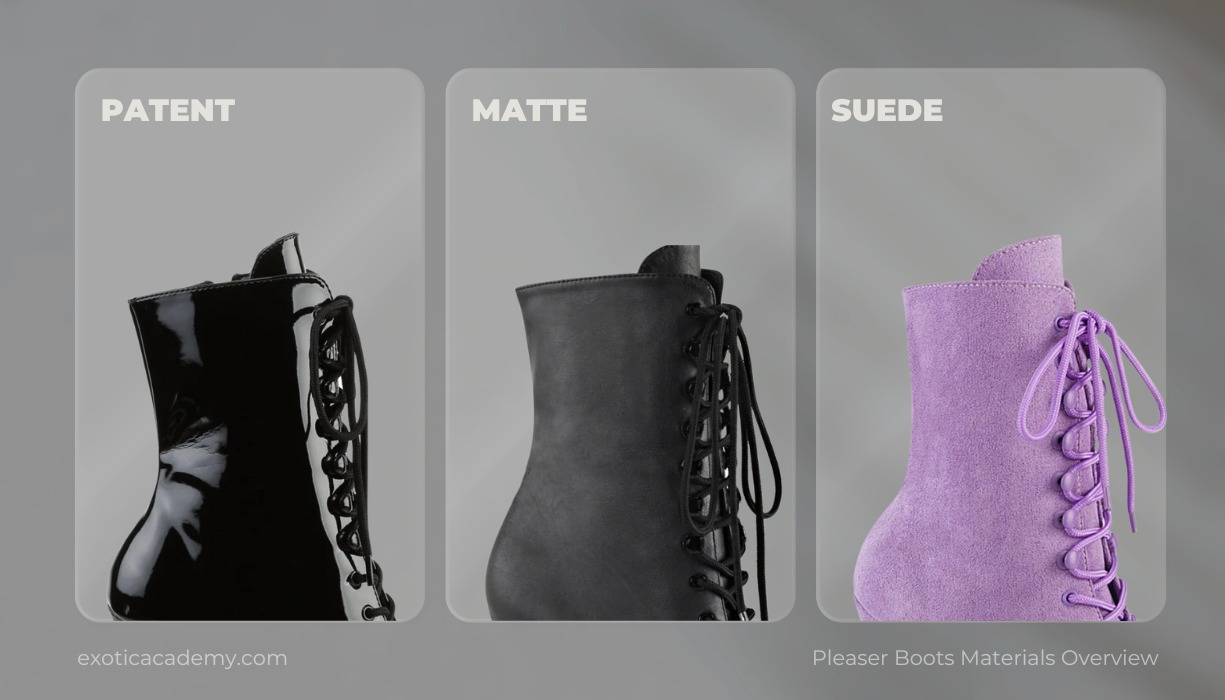
Pole Dancing Shoes for Beginners – A Complete Guide
Thinking about getting your first pair of pole dancing shoes? We get it—those shiny heels are hard to resist! But with so many choices out there, picking the right pair can be a bit overwhelming. Don’t worry, though! In this guide, we’ll walk you through all the important details to help you start your pole dancing journey off on the right foot.
Are Pole Dancing Shoes Even Necessary?
If you’re just starting out, you might be wondering—do you even need shoes for pole? The short answer: not right away. If you’re taking first classes, whether in a studio or online, you can absolutely try pole dancing barefoot or in socks to see if you enjoy it. There’s no need to rush into buying shoes before you know whether this style is right for you.
However, if the pole heels look is something you’re drawn to, or if you plan on diving into exotic pole dancing, shoes quickly become an essential part of the craft. Exotic pole style is all about the heels, and certain moves or techniques simply can’t be executed without the right footwear. The shoes you choose will become an important tool to help you elevate your dance and perform at your best.
Let’s Talk Heel Height: 6″, 7″, or 8″?
These sky-high heels may seem a little bit scary at first glance, but don’t worry! Most of the height comes from the platform, and the actual heel height is comfortable for dancing. The heel and its angle are similar across models. So, while these shoes may seem like they’re about to launch you into orbit, you will be surprised when you first try them and see how cosy they are.

6-Inch Heels
While 6-inch heels might seem like a safe choice for beginners, they can actually be limiting in the long run, especially if you want to learn the Flow style. Most dancers outgrow them pretty fast and regret not starting with 7 inches. The platform of the shoe is essential to perform certain techniques and this one doesn’t give you much room to work with and can hold you back as you progress. Plus, they often don’t give you the right amount of lift to really showcase your moves.
Only go for 6-inch heels if you’re genuinely terrified of high heels and need a slow introduction to the pole.
7-Inch Heels
Not too high, not too low—7 inches are just right. They might look intimidating at first glance, but once you slip them on, you’ll realize they’re way more manageable than you expected. The platform gives you enough height to start learning the correct technique (and looking fabulous while doing it) without feeling like you’re walking on stilts. They’re stable, supportive, and comfy enough to let you focus on building strength and flow.
That’s why most beginners—and a ton of experienced dancers—swear by them as their go-to heel height.
8-Inch Heels
Now, let’s talk about 8-inch heels. These are super trendy and loved by advanced dancers, but they’re not beginner-friendly for most.
Here’s the thing: you may have heard some dancers say 8-inch heels feel easier to “get on pointe” in. That’s actually true—the steeper angle allows you more range of motion. BUT that’s only helpful if you already have ankle strength and mobility, which let’s face it, most beginners don’t.
8-inch heels are designed for more advanced pole techniques. We don’t recommend them for beginners unless you’ve got experience dancing in heels (or pointe shoes) and have developed the necessary ankle stability. Starting with 7-inch heels gives you a solid foundation before you move up to higher platforms.
Sandals vs. Boots: Which Pole Heels are Better for Beginners?
Now, onto the age-old debate: boots or sandals? Which is better for your first pair of pole heels? Well, we lean more towards recommending sandals for beginners, but ultimately, it’s up to you! Let’s break it down:
Sandals
We usually recommend sandals for beginners because they’re flexible and generally more versatile. They work on the pole and during floorwork very well. Open design allow for greater foot and ankle mobility which is important as you work on your footwork and skills. Plus, they’re often more affordable, making them perfect for getting started. It’s the perfect balance of comfort, support, and style to help you get started without feeling too restricted.
Boots
We love boots because they offer extra ankle support and stability, which can be comforting when you’re first starting out. They make you feel more secure, and for some, that added coverage can be a confidence booster. There’s a common myth that boots prevent you from improving your footwork. This isn’t true! Your feet still work inside boots (providing they are not laced too tight). Proper footwork and ankle conditioning should be done without heels too anyway.
That said, boots can be more expensive, and depending on the material, they may not be as versatile as sandals (which we’ll explain further in the material section). This can be a tricky choice since you’re still figuring out your preferred dance style. If you’re new to pole, it’s a good idea to start with sandals to get a feel for the sport before investing in pricey boots. But if boots are your vibe, go for it.
If you’re curious and want a full breakdown of boots vs. sandals, we’ve got a whole article just for that! Check it out for more details.

Things to Think About When Choosing Sandals
So you’re leaning toward sandals? Good call—we usually recommend them for beginners. They’re light, flexible, and give you a great feel for the pole and floor. But not all sandals are the same, and a few details can make a big difference.
Platform Finish
Let’s start with what you’re stepping on. Platforms come in all kinds of finishes—from glittery showstoppers to sleek and simple. Your choice is totally personal, but here’s what we suggest:
- Clear or semi-clear platforms (especially ones with glitter inside) are the real MVPs. They’re durable, they don’t show scratches easily, and they match pretty much anything. That makes them a super smart choice for your first pair.
- Coloured platforms look fun and bold, but they can show wear quickly. If you’re still figuring out if pole heels are for you, maybe hold off on these until you’re ready to commit.
- Glitter or rhinestones on the outside? Stunning—but delicate. These tend to lose their sparkle with heavy use, so save them for special occasions or performances.
Upper Shoe Material
The top of the sandal matters just as much as the bottom. It affects how the shoe fits and how comfy you’ll feel dancing in them.
- Clear plastic or jelly straps usually feel snug at first, but don’t worry—they’ll stretch and mold to your foot as they warm up. Great if your feet are on the narrow side.
- Patent leather straps (the shiny ones) are roomier and a bit stiffer. They’re great if you have wider feet or want a little more structure around the toes.
Ankle Straps
Don’t sleep on the ankle straps—they keep your foot secure and supported while you dance. Some designs don’t have them, and you should definitely avoid these for dancing.
- Wider ankle straps, which you’ll often find in clear or jelly-style sandals, are perfect for beginners. They make the shoe feel more stable and help with confidence.
- Thin patent leather straps might look sleek, but they don’t offer as much support and can stretch out faster.
Whichever style you pick, remember that all materials stretch with time. And if you want to keep your shoes looking fresh? Grab some platform protectors—they’ll save your shoes from scuffs and make them last longer.

Things to Think About When Choosing Boots
Boots have a vibe. They’re bold, secure, and give you great ankle support—perfect for flowy exotic styles. Just stick with classic, full-coverage boots to start. Some strappy or open-heel designs might look cool, but they often lack the support beginners need. If you’re going the boot route, here’s what to look out for.
Boot Material Options
The outside finish of your boots changes how they feel, how they move, and how they grip the pole or floor. Here’s a breakdown:
- Patent (shiny) leather is eye-catching and gives you great grip on the pole. But it’s stiff at first, and can make your feet sweaty. Bonus: it helps with certain tricks, but it might stick too much during floorwork.
- Matte faux leather is a great middle ground. It doesn’t add extra grip, but it won’t get in the way either. It’s also more flexible than patent and less delicate than suede.
- Faux suede is the softest, most flexible material. It’s amazing for flowy floorwork and comfy dancing—but it offers zero pole grip, which can make climbing harder for beginners.
To pick the right one, think about how you like to move. More tricks and climbing? You might want something grippy. More flow and floorwork? Softer, smoother finishes will feel best.

Open-Toe or Closed-Toe Boots?
This one’s all about comfort and style. Both work for beginners, but they feel different:
- Closed-toe boots give your toes extra protection and help prevent stubbed nails or bruises during floorwork. They also make the shoe feel a little more solid. In our opinion, trhe biggest drawback is they do not allow to showcase a the footwork and foot arch is not visible in them.
- Open-toe boots show off your footwork and feel a bit more like a hybrid between sandals. A lot of dancers prefer them for flow style. But if your feet are narrow, your toes might slide forward—something to keep in mind.
Size Matters: How to Find Your Perfect Fit
Getting the right fit is everything—not just for comfort, but for safety too. When you try on your shoes, your toes should sit inside the platform—not creeping over the edge. A little bit of sliding during a long session is normal at first—you’ll eventually learn how to grip with your toes and control that. But if they’re already spilling out when you’re just standing still? That’s a no-go.
First, measure your feet
Sounds basic, but it’s super important. Grab a measuring tape and compare your measurements to the brand’s size chart—don’t rely on your usual shoe size. Sizing can vary wildly between brands (a 7 in sneakers is not the same as a 7 in Pleasers!).
Know your foot shape
Are your feet narrow? Wide? Somewhere in between? Knowing your foot shape can save you a ton of frustration when picking your first pair of pole dancing shoes. If you’re not sure, try measuring the ball girth of your foot (the widest part) and compare it to standard sizing charts to get a rough idea of where you fall. Unfortunately, Pleasers don’t provide ball girth charts, but this can still give you a helpful reference point.
If you’re between sizes, it’s always best to try both if possible—especially since fit can vary between models and materials.If you have narrow feet, don’t size down hoping it’ll solve everything. Instead, go for styles that run tighter—like Pleasers Jelly models or Hella Heels, which tend to hug the foot more snugly.
Still Unsure? Try These Tips Before Buying Pole Dancing Shoes
🔁 Check with your studio – Some pole studios rent or sell heels. Trying on a few pairs there can give you a better sense of what works for your feet.
🛍 Visit an adult store – Many adult stores carry pole dancing shoes like Pleasers and similar brands. It’s a low-pressure way to test sizes and styles in person.
📦 Order multiple sizes online – If you’re shopping online, order more than one size to try at home. Just make sure to check the return policy first—some stores make returns super easy, others… not so much
Finding your perfect pole heel might take a little trial and error—but once you nail the fit, your feet (and your dancing) will thank you.
Choose Reputable Pole Heels Brands for Safety and Quality
When it comes to pole dancing shoes, quality and safety are key. It’s tempting to go for cheaper alternatives or knock-offs, but we cannot stress enough how important it is to invest in a reputable brand. Pleasers are one of the most trusted names in pole shoes, offering durability, comfort, and safety in their designs. Another solid option is Hella Heels, known for their stylish and supportive heels that cater to various foot shapes and dancing styles.
Avoid suspiciously cheap fake alternatives, as these shoes may not provide the support you need, and can even increase your risk of injury. Your feet (and your dance moves) deserve the best!
Your Perfect Pole Shoes Are Out There!
We hope this guide has helped clear up some of the confusion and made your shoe shopping experience a bit easier. With the right pair of pole dancing shoes, you’ll feel more confident and ready to take on your next pole session with style and comfort. Remember, finding the perfect fit takes time, so don’t be afraid to try different styles until you find the one that works best for you!

Sign in to comment!